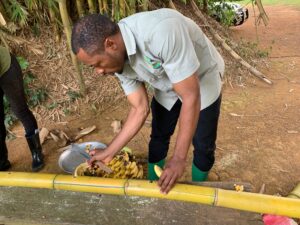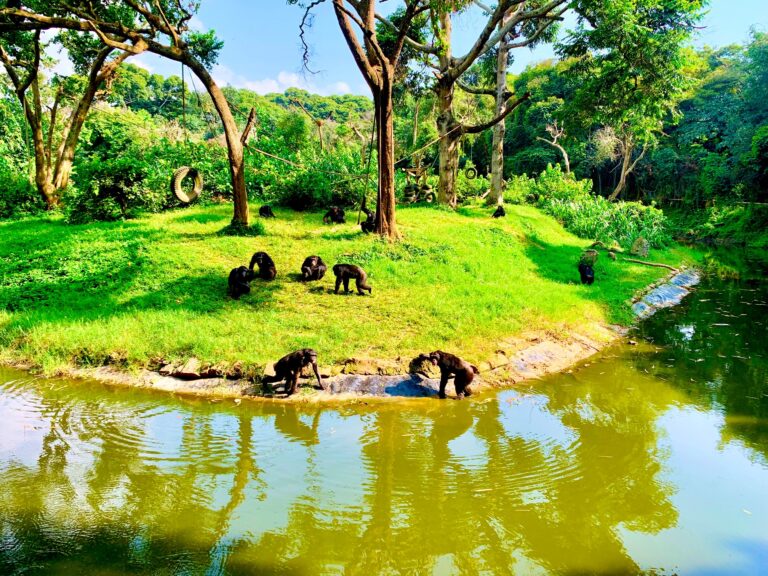Celebrating our closest wild cousins- the chimpanzees, would bear no essence if devising strategies towards ending threats that continue to face these endangered species remain mere talk.
With the growing human population and the decreasing numbers of the chimpanzees, it has never been more imperative for humans to be intentional about preserving the environment that is home to the chimps and minimizing the human-chimpanzee conflict that’s forcing more of these great apes into captivity where they ideally don’t belong.
While folks pulled out the army green t-shirts with chimp prints and headed for the Ngamba Chimpanzee Sanctuary to celebrate the World Chimpanzee Day and make merry on July 14th, for entities like the Uganda Wildlife Education Conservation Center (UWEC), such a day is more than just a celebration, it’s about looking back at the long journey traded since the 1970’s when the rescue of orphaned, injured or confiscated chimpanzees gained momentum; the highs, the lows and everything in between.
Under the UWEC Act 2015, UWEC is mandated to rescue, rehabilitate and release animals back into the wild. Most of the chimpanzee rescues are got between 0-5 years, the youngest having been 3 weeks old.
James Musinguzi, UWEC ED, says at the national level, the stakeholders are finalizing the Chimpanzee Conservation Strategy that outlines various concrete steps and actions that can be done to improve the welfare of the chimpanzees in their care.
“Conserving the chimpanzees is a national concern because apart from the fact that their numbers are decreasing worldwide, they are intelligent animals which must be handled with utmost care, safety and security. They are critical in promoting tourism in our country but we also need them for other generations to come. It will be great for our great grand children to find chimpanzees physically and not just study about them in books,” Musinguzi emphasizes.
He notes that chimpanzees are vital for research especially studying the evolution of disease and medicine.

Threats facing Chimpanzees
There is no better way to counter the decreasing chimpanzee numbers than educating ourselves on the root cause of the issue. Tracing the cause is no rocket science and is certainly not a concept only wildlife welfare advocates or the government should be left to dissect.
From environmental degradation which causes habitat loss to operations of money-hungry cartels looking to make millions off exotic pet trading while they satiate the needs and demands of illegal markets in countries like China, the causes are quite appalling.
Habitat Loss
Activities like deforestation for commercial purposes, illegal logging in gazetted forests and encroachment on pristine ecosystems for urban development among other reasons are contributing immensely to rapid habitat loss for the chimpanzees that survive in tropical rainforests, woodlands and grasslands.
A case in point is the conflict between the chimpanzee and the timber trader; the former prefers the Uganda Ironwood for a good night’s sleep while the latter lumbers the trees for their renowned heavy timber that is resistant to abrasion and termite attack- a prized quality fetching traders an extra penny.
“People are destroying forests in areas of Bunyoro, Kibale, Budongo, Karinzu and this is where we have huge populations of chimpanzees. This is the biggest conflict between human and chimps- fighting for the limited habitat,” says David Musingo, the Director Education and Information Department at UWEC.
Exotic Pet Trade
The term exotic pet refers to a wild animal or one that’s more unusual than the traditional pets, taken from their natural habitats to live in homes as pets.
While this might sound like a wild notion for many, it’s no secret that people have kept exotic pets throughout history, be it tigers, turtles, monkeys, chimpanzees among others. This is not unique to the western world as many assume, in fact, Musingo says 40% of the chimpanzees at the facility were picked from private homes where they were being kept as pets.
According to Dan Mirembe, a zoo keeper and the head of the Primates Section at UWEC, this interaction not only denies the animals a right to live freely in the wild like they should “but also poses a risk of attack on the owner as well as spread of zoonotic diseases.”
“Some of these animals can escape from the homes and cause mayhem in the community. So, before they are harmed by rowdy community members, we rescue them, rehabilitate and integrate them with the existing group here,” Mirembe adds.

Poaching
Chimpanzees are poached for meat by some communities especially in the Democratic Republic of Congo (DRC) and others along the Uganda-Congo boarder.
“Our neighbors on the DRC side have chimpanzee meat as a delicacy. They hunt down these apes ad slaughter them for consumption,” Musingo says.
He added that the hairs of the chimpanzees are also sought after by individuals who practice sorcery; “apparently, they use the chimp hair in the concoction of some charms and portions.”
Zoonotic Diseases
Since Chimps are so much genetically related to humans, Musingo says, the diseases that affect human beings also affect chimpanzees for example, ebola, Hepatitis, zoonotic influenza among others.
“When these diseases occur, we have numerous deaths which also reduces the number of chimpanzees in addition to increasing the number of leave orphaned baby chimps that might not survive infancy,” he noted, emphasizing that the zoonotic diseases are usually triggered by interaction between the humans and animals.
UWEC Strategies to Conserve Chimpanzees
Giving Rescues a second chance at life
Musingo notes that revamping UWEC as needed makes the center a suitable second home for the chimpanzees much as it cannot replace their natural habitat.
“We have created a conducive environment for the chimps, the island is naturalistic where they are, we provide them we the basic nutrition and medication. We have a good facility where they sleep so we believe that for all the rescues that can’t be released, this is a place they can call home, even though it cannot be like nature,” he says.
Relocation to other places
According to Musingo, the Budongo Island that hosts Chimpanzees at UWEC has reached its carrying capacity and the center cannot continue receiving animals.
“We are looking into identifying another area where we can relocate the chimpanzees for better living. We have many islands in Lake Victoria, we are thinking of taking some chimpanzees to the vast islands and elsewhere where there are forests but without existing chimpanzees,” Musingo said.
He added, “Chimpanzees, especially adults, cannot be relocated to a place with another community of chimpanzees. It will cause conflict and deadly wars among the two groups. We have to identify a virgin area that can make home for a new group.”

Community Engagements to Counter Human-Chimpanzee conflicts
Through initiatives like the Chimp Connect Program, an intervention put in place to enable communities and individuals learn about, connect with and support chimpanzees both in the wild and in captivity, UWEC aims at getting members of the public to do individual-conservation actions like supporting chimps through purchase of customized products.
“For example, we have travel mugs and other branded items that bear images of the chimpanzees like the late Zakaayo and his wives. These images tell stories behind the characters and we believe through such connections, people will be more aware of the plight of chimpanzees and work towards their conservation,” says Slovia Asiimwe, a Primates Keeper at UWEC.
“When you buy these chimpanzee branded souvenirs, you are supporting chimpanzee conservation. 20% of the proceeds actually goes back to the communities where these chimpanzees were rescued from. You can donate to become a chimp guardian, parent or name a chimpanzee, all these actions serve purposes of awareness creation as regards conservation so I call upon all the people to participate,” she adds.

The Rescue, Rehabilitation and Release Cycle
Chimpanzees live in a community setting where matters of hierarchy, territory, social cohesion and ‘chimp politics’ govern the life of the individuals. This setting dictates who lives where, with whom and who does what- which particularly makes reintroduction of rescues into the wild or captive groups, a daunting task both for the zoo keepers and the rescued animal.
Dan Mirembe says despite the difficulties expected along the rehabilitation and reintroduction journey, wellbeing must be prioritized if the animal is to “keep sane and not be weighed down by effects of isolation during quarantine because chimpanzees are very social creatures.”
Rescue
99% of animals at UWEC were rescued or confiscated from different parts of the country largely as a result of exotic pet trade, trafficking and human-wildlife confrontations. This is done through liaison with community members who report stray animals, exotic pets and field operations by UWEC personnel.
Since 1970, about 70 chimpanzees have been rescued by UWEC. One has been reintroduced to the wild, 13 were taken to the Ngamba Island Chimpanzee Sanctuary while others remain at the center.
“Currently, we have 23 chimpanzees here at UWEC,” said Dr. Rachael Mbabazi, Manager Animal and Horticulture Department at UWEC.
Quarantine
Once a rescue gets to the center, it undergoes quarantine during which the veterinary department makes the necessary procedures like drawing blood samples to ascertain if they have diseases or any other health concerns.
“This is done to prevent spread of infections around the center. When these rescues are brought in, it is mandatory that we make necessary tests so that incase of diseases, they can be contained, treated without affecting the other animals,” Mirembe said.
The quarantine also helps them get used to the new environment.
Animal Integration
This entails the incorporation of individual animals to existing groups but of the same species, to live as a group. The success of the integration depends on the analysis of the caretaker as regards the character and personalities of the animal.
“The success of the integration is also determined by the circumstance under which the animal was rescued. The sex and age of the animal also matter in this regard. The essence of integrating animals is to safeguard them from effects related to stress that could build up from the isolation. Considering chimpanzees are social animals, isolation from a group, or in this case longer periods before integration cause the chimps stress and therefore makes them susceptible to zoonotic diseases,” Mirembe further explained.
—
There are approximately 150,000- 350,000 wild chimpanzees across Africa and Uganda has an estimated 5000 individuals. 100 years ago, there was an estimated 1-2 million chimps across 25 countries in Africa. This is evident of the mass decrease of these apes an a wake up call to preserve the species.

